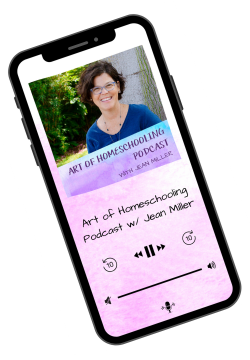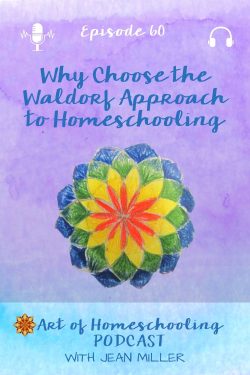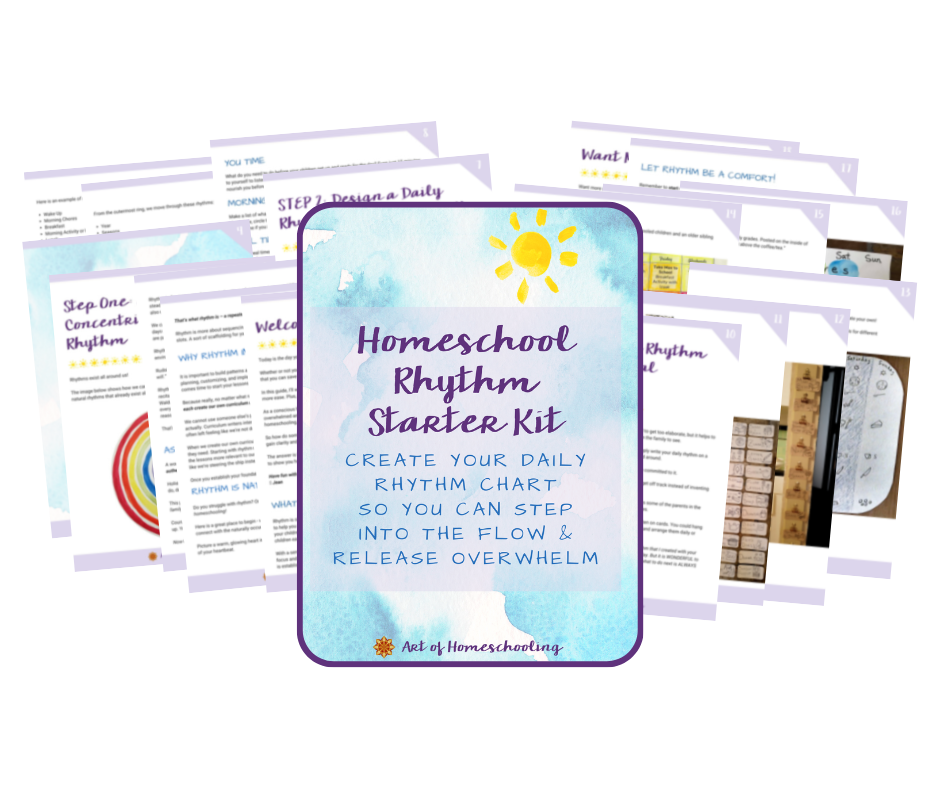Episode 60
Why did I choose the Waldorf approach for homeschooling?
Friend, in this episode of the Art of Homeschooling podcast, I want to share with you what appeals to me most about Waldorf and why I chose the Waldorf approach for homeschooling.
No matter where you are on your homeschooling journey or what your homeschool looks like, I think the ideas I have to share here can help you clarify the focus and direction of YOUR homeschooling journey. And maybe you’ll choose to weave more Waldorf-inspired or hands-on activities into your lessons, too.
When we understand and feel committed to the reasons behind our choices, that becomes our motivation to stay the course and keep going!
If you’re new to my podcast and you haven’t heard about my path to homeschooling, you might want to have a listen to Episode 1: Homeschooling is a Journey. In that episode, I share stories of my family’s journey from the very beginning all the way through graduating three kids.
In this episode, I want to dive a little deeper into my homeschooling journey, and specifically why I chose the Waldorf approach as my main source of inspiration. So that you can then decide for yourself what inspires you and keeps you going as a homeschooling parent.
Let’s Put Waldorf in Context
Waldorf education has always resonated deeply with me. Throughout the twists and turns of my homeschooling journey, I’ve always found my way back to the Waldorf approach. It really speaks to me, probably to us all, on a deeper level. And I often say it feeds our souls.
The one thing I wish I’d known earlier is that weaving in even small pieces of inspiration from the Waldorf approach into your homeschool and for your children is worth it! It’s not all or nothing.
So often, we compare ourselves to the vision of Waldorf education as it’s portrayed on social media. But the root of the Waldorf method is in the philosophy, the pedagogy behind these tangible images. The how’s and why’s of the method are so much more than Pinterest or Instagram images.
Here are a few insights to ground us as we explore more:
- The Waldorf method was created by Rudolf Steiner over 100 years ago, for the classroom setting.
- Steiner never wrote down a prescribed curriculum. Many believe he intended to, but never had a chance before his death 5 ½ years after the opening of the first Waldorf school.
- The curriculum was created then by piecing together Steiner’s lectures and writing…and by trial and error. Most of what we have available in terms of curriculum today comes from translating current classroom practice in Waldorf schools…which base their practices on what’s evolved from that first school back in the early 1900s.
The first teacher training took place in August of 1919 when Steiner presented a two week series of lectures. And after these two weeks of preparation, the school opened its doors. Just imagine that! Two weeks to prepare ~ so amazing!
Want to hear more about that first school? Check out Episode #43, Top Ten Lessons from Steiner’s 1919 Seminar Course .
To me, these details of history are so encouraging and freeing!
“What Steiner had to say leaves open many more possibilities than are available in practice today.” ~Stephen Sagarin
Why Choose the Waldorf Approach to Homeschooling?
So here’s my one sentence elevator pitch for Waldorf homeschooling. Are you ready?
“Waldorf education is a developmental approach to learning that incorporates rhythm and the lively arts into all the lessons.”
First of all, Waldorf is a Developmental Approach: The Waldorf curriculum and all the lessons and learning are derived from the stages of child development. Steiner identified three stages of child development, ages 0 to 7, ages 7 to 14, and ages 14 to 21.
Each stage is influenced by the learning and development taking place in the body and will, the imagination and emotions, and finally abstract thinking. This is the origin of the phrase “Head, Heart, and Hands.”
In my observation, mainstream learning takes place mainly in the abstract realm of head learning. For example, the traditional textbook-based learning with the goal of filling a child with knowledge. In comparison, Steiner’s developmental approach is more holistic, responsive to the child, and enlightening.
Second, Waldorf incorporates Rhythm: The predictable rhythms of the changing seasons, the passing days throughout the week, and the comfortable order of each day’s activities provide the security children need to grow and learn.
The importance of sleep is emphasized in the two-day rhythm of the lessons and learning for school age children. As well as alternating lively and calm activities throughout the day.
Brain science has proven that the best learning takes place when children are happy and secure. Steiner’s observations of child development allowed him to see this and the importance of rhythm.
Third, Waldorf incorporates the Lively Arts into all the lessons: Storytelling, music, movement, drama, poetry, painting, drawing, and modeling are woven into the learning from kindergarten through the grades in the Waldorf approach.
Children develop both capacities and skills through lively, artistic work. And I’ve seen so many times that the arts can inspire focus, improve engagement and memory, and foster active learning.
If you’re curious about teaching through stories, you’ll want to listen to Episode #16, Stories Make Great Teachers.
And I want to add a fourth bonus component of the Waldorf approach: Honoring the inner life and personal development of the teacher(parent). In Waldorf circles, this is called Inner Work. And it’s true that you, dear homeschooling parent, are on a journey of discovery right along with your children.
Our goal, then, is to “secure the strengthening of the will through artistic means.” ~Rudolf Steiner
A developmental approach, rhythm, the lively arts, and inner work. This is what draws me to the Waldorf approach.
Waldorf is Experiential Learning
Many methods of holistic homeschooling are considered experiential, such as Waldorf, Montessori, and the Charlotte Mason approach.
According to the Association of Experiential Education: “experiential education is a philosophy…in which educators purposefully engage with learners in direct experience and focused reflection in order to increase knowledge, develop skills, clarify values, and develop people’s capacities to contribute to their communities.”
From my experience in graduate school (earning my Master of Arts in Teaching) to my experience with my own young children, I knew I wanted my teaching to be experiential. And when we chose to homeschool, I set out to dig deeper into these hands-on approaches: Charlotte Mason, Montessori, and Waldorf.
And though I found that I often combined different approaches ~ as I’m sure you all do, too ~ what I was drawn to most about Waldorf was the deep, human connection established.
“Waldorf homeschooling is the best of the best!” ~Alan Whitehead, author of “A Waldorf Homeschool?”
I just love this quote about Waldorf homeschooling calling it the best of the best! Waldorf homeschoolers get the independence of homeschooling coupled with the hands-on experiential approach that’s so rich in memorable learning, stories, the arts, and connections.
So why choose the Waldorf approach for homeschooling? Here’s what I’ve discovered to be so very true of Waldorf-inspired homeschooling…
This approach really does inspire life-long learning in children and enable them to fully develop their unique capacities.
The Waldorf approach is a holistic liberal arts education where subjects are not separated from one another and education honors a child’s body, mind, and spirit.
Additionally, in a homeschool setting, we have the benefit of focusing on lessons for part of the day and then also having time for our children to explore their own interests, as well. Waldorf homeschooling truly is the best of the best!
I hope this has helped you consider more deeply your own homeschooling approach.
Find More Waldorf Inspiration Here…
Inside the Inspired at Home membership community!
If you want to weave more of the Waldorf approach to your homeschool, I invite you to join me and a wonderful group of homeschooling parents like you inside Inspired at Home. This monthly membership offers classes, coaching, and community so you can create a homeschooling life you love that’s simple, inspiring, and doable.
Rate & Review the Podcast
If the Art of Homeschooling Podcast has inspired you, I’d LOVE it if you could rate and review the podcast on your favorite podcast player! Reviews can be left on Apple Podcasts (iTunes), Podcast Addict, or Stitcher.
Or simply pop on over to lovethepodcast.com/artofhomeschooling and choose where you want to leave your review.
And if you want to show your appreciation for the Art of Homeschooling Podcast, you can buy me a coffee!
Never Miss an Episode!
 Listen & Follow:
Listen & Follow:


Check Out All the Episode Here (<<<Click that link!)
Save or share this encouragement on Pinterest with the image below.



